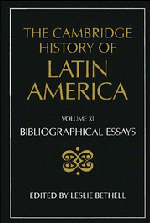Book contents
- Frontmatter
- I THE INDIGENOUS PEOPLES OF MIDDLE AND SOUTH AMERICA ON THE EVE OF THE CONQUEST
- II COLONIAL SPANISH AMERICA
- III COLONIAL BRAZIL
- IV THE INDEPENDENCE OF LATIN AMERICA
- V LATIN AMERICA: ECONOMY, SOCIETY, POLITICS, c. 1820 TO c. 1870
- VI LATIN AMERICA: ECONOMY, SOCIETY, POLITICS, c. 1870 to 1930
- 1 Latin America and the international economy, 1870–1914
- 2 Latin America and the international economy, 1914–1929
- 3 Population
- 4 Rural Spanish America
- 5 The growth of cities
- 6 Industry
- 7 The urban working class and early labour movements
- 8 The Catholic church
- 9 Mexico: Restored republic and Porfiriato, 1867–1910
- 10 The Mexican Revolution, 1910–1920
- 11 Mexico: Revolution and reconstruction in the 1920s
- 12 Central America
- 13 Cuba
- 14 Puerto Rico
- 15 The Dominican Republic
- 16 Haiti
- 17 Argentina: Economy, 1870–1914
- 18 Argentina: Society and politics, 1880–1916
- 19 Argentina, 1914–1930
- 20 Uruguay
- 21 Paraguay
- 22 Chile
- 23 Bolivia
- 24 Peru
- 25 Colombia
- 26 Ecuador
- 27 Venezuela
- 28 Brazil: Economy
- 29 Brazil: Society and politics, 1870–1889
- 30 Brazil: Society and politics, 1889–1930
- VII LATIN AMERICA: ECONOMY, SOCIETY, POLITICS, 1930 to c. 1990
- VIII IDEAS IN LATIN AMERICA SINCE INDEPENDENCE
- IX LATIN AMERICAN CULTURE SINCE INDEPENDENCE
- X THE INTERNATIONAL RELATIONS OF LATIN AMERICA SINCE INDEPENDENCE
- THE CAMBRIDGE HISTORY OF LATIN AMERICA
19 - Argentina, 1914–1930
from VI - LATIN AMERICA: ECONOMY, SOCIETY, POLITICS, c. 1870 to 1930
Published online by Cambridge University Press: 28 March 2008
- Frontmatter
- I THE INDIGENOUS PEOPLES OF MIDDLE AND SOUTH AMERICA ON THE EVE OF THE CONQUEST
- II COLONIAL SPANISH AMERICA
- III COLONIAL BRAZIL
- IV THE INDEPENDENCE OF LATIN AMERICA
- V LATIN AMERICA: ECONOMY, SOCIETY, POLITICS, c. 1820 TO c. 1870
- VI LATIN AMERICA: ECONOMY, SOCIETY, POLITICS, c. 1870 to 1930
- 1 Latin America and the international economy, 1870–1914
- 2 Latin America and the international economy, 1914–1929
- 3 Population
- 4 Rural Spanish America
- 5 The growth of cities
- 6 Industry
- 7 The urban working class and early labour movements
- 8 The Catholic church
- 9 Mexico: Restored republic and Porfiriato, 1867–1910
- 10 The Mexican Revolution, 1910–1920
- 11 Mexico: Revolution and reconstruction in the 1920s
- 12 Central America
- 13 Cuba
- 14 Puerto Rico
- 15 The Dominican Republic
- 16 Haiti
- 17 Argentina: Economy, 1870–1914
- 18 Argentina: Society and politics, 1880–1916
- 19 Argentina, 1914–1930
- 20 Uruguay
- 21 Paraguay
- 22 Chile
- 23 Bolivia
- 24 Peru
- 25 Colombia
- 26 Ecuador
- 27 Venezuela
- 28 Brazil: Economy
- 29 Brazil: Society and politics, 1870–1889
- 30 Brazil: Society and politics, 1889–1930
- VII LATIN AMERICA: ECONOMY, SOCIETY, POLITICS, 1930 to c. 1990
- VIII IDEAS IN LATIN AMERICA SINCE INDEPENDENCE
- IX LATIN AMERICAN CULTURE SINCE INDEPENDENCE
- X THE INTERNATIONAL RELATIONS OF LATIN AMERICA SINCE INDEPENDENCE
- THE CAMBRIDGE HISTORY OF LATIN AMERICA
Summary
A major statistical source for the study of Argentina on the eve of the First World War is Ernesto Tornquist, The Economic Development of the Argentine Republic in the Last Fifty Years (Buenos Aires, 1919). For the war period itself students should also consult Tornquist’s quarterly publication, Business Conditions in Argentina (Buenos Aires, 1913–22). A second source of information is the writings of Alejandro E. Bunge. See his Ferrocarriles argentinos (Buenos Aires, 1917) and Los problemas económicos del presente (1919; Buenos Aires, 1979). Both are encyclopaedic collections of facts and figures. Slightly later came Bunge’s La economia argentina, 4 vols. (Buenos Aires, 1928–30), a work containing many of the author’s press writings from past years and articles from a major journal he edited, the Revista de Economía Argentina. Other important publications are the national census of 1914, Tercer Censo National (Buenos Aires, 1915–17), which is far more than a mere population count, and Alberto B. Martínez and Maurice Lewandowski, The Argentine in the Twentieth Century (London, 1911). For population, see also Recensement général de la ville de Buenos Aires (Buenos Aires, 1910).
The most outstanding contemporary study of Argentina from abroad is the publication by Lloyd’s Bank to celebrate the centennial anniversary of 1910: Reginald Lloyd (ed.), Twentieth Century Impressions of Argentina: Its History, People, Commerce, Industries and Resources (London, 1911). Pierre Denis, The Argentine Republic: Its Development and Progress, translated by Joseph McCabe (London, 1922), is a useful geographical survey by a Frenchman, though much inferior to its predecessor from the 1860s by Martin de Moussy.
- Type
- Chapter
- Information
- The Cambridge History of Latin America , pp. 442 - 445Publisher: Cambridge University PressPrint publication year: 1995

